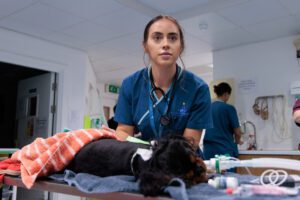Conclusion
This case report outlines a challenging diagnosis of ectopic spinal choroid plexus papilloma without a primary intracranial neoplasm. The importance of immunohistochemical evaluation aligned with histological growth pattern were crucial to the characterisation and differential diagnosis of this neoplasm, which was reinforced by survival time without reoccurrence.
Summary
A 10-year-old male neutered Russian Blue cat was presented with a 2-month history of progressive non-ambulatory paraparesis. Spinal MRI revealed a well-demarcated, compressive intradural extramedullary mass at the level of T1 vertebra. The mass had subtle hyperintensity on T2-weighted images, was isointense on T1-weighted images and had diffuse, marked enhancement following gadolinium administration. Neuroaxis MRI, including limited brain sequences, excluded other visible lesions. Thoracic and abdominal radiographs were unremarkable. The mass was resected via a dorsal C7–T2 laminectomy and durotomy. Histopathology revealed a neoplasm composed of columnar-to-polygonal cells forming bilayered palisading patterns with a few apical cilia. Three mitoses were noted in 10 high-power fields. This was consistent with an epithelial neoplasm and initially a metastatic adenocarcinoma was considered most likely. Full-body CT with contrast and including the brain found rhinitis but did not identify any additional neoplastic foci. Biopsies of the nasal cavity and fine-needle aspiration of the spleen and liver were unremarkable. On immunohistochemical evaluation, pan-cytokeratin and E-cadherin immunolabelling was observed; however, synaptophysin, thyroglobulin, chromogranin A and glial fibrillary acidic protein was not detected. This, along with the histological morphology and absence of a primary tumour, was compatible with an ectopic choroid plexus neoplasm. Follow-up performed at 3, 14 and 24 months postoperatively revealed neurological improvement without recurrence.



